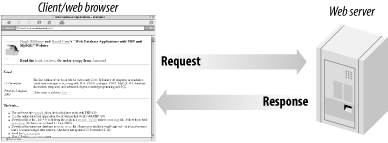1.1 The Web
When you browse the Web, you use your web browser to request
resources from a web server and the web server responds with the
resources. You make these requests by filling in and submitting
forms, clicking on links, or typing URLs into your browser. Often,
resources are static HTML pages that are displayed in the browser.
Figure 1-1 shows how a web browser communicates
with a web server to retrieve this book's home page.
This is the classic
two-tier or client-server
architecture used on the Web.

A
web server is
not sophisticated storage software. Complicated operations on data,
done by commercial sites and anyone else presenting lots of dynamic
data, should be handled by a separate database. This leads to a more
complex architecture with three-tiers: the browser is still the
client tier, the web server becomes the middle tier, and the database
is the third or database tier. Figure 1-2 shows how
a web browser requests a resource that's generated
from a database, and how the database and web server respond to the
request.

|

